GIS Partial Discharge Pattern Recognition Based on Multi-Feature Information Fusion of PRPD Image
Abstract
1. Introduction
2. Method
2.1. Method Overview
2.2. Statistical Features Channel
2.2.1. Statistical Features Extraction
2.2.2. Hausdorff-like Distance Algorithm
2.2.3. Implementation of PD Type Recognition
2.3. Image Features Channel
2.3.1. Input Layer
2.3.2. Feature Extraction Layer
2.3.3. Classification Output Layer
2.4. Fusion Recognition Decision Based on D–S Evidence Theory
3. Experimentation
3.1. Recognition Performance Based on Different Size Training Sets
3.2. Recognition Performance Based on Different Recognition Method
3.3. Field Case Analysis
4. Conclusions
Author Contributions
Funding
Institutional Review Board Statement
Informed Consent Statement
Data Availability Statement
Conflicts of Interest
References
- Han, X.; Li, J.; Zhang, L.; Pang, P.; Shen, S. A novel pd detection technique for use in gis based on a combination of uhf and optical sensors. IEEE Trans. Instrum. Meas. 2018, 68, 2890–2897. [Google Scholar] [CrossRef]
- Mor, A.R.; Heredia, L.C.C.; Muñoz, F.A. A novel approach for partial discharge measurements on gis using hfct sensors. Sensors 2018, 18, 4482. [Google Scholar]
- Jing, Q.; Yan, J.; Lu, L.; Xu, Y.; Yang, F. A novel method for pattern recognition of gis partial discharge via multi-information ensemble learning. Entropy 2022, 24, 954. [Google Scholar] [CrossRef] [PubMed]
- Li, P.; Peng, X.; Yin, K.; Xue, Y.; Wang, R.; Ma, Z. 3d localization method of partial discharge in air-insulated substation based on improved particle swarm optimization algorithm. Symmetry 2022, 14, 1241. [Google Scholar] [CrossRef]
- Wu, Z.; Lyu, B.; Zhang, Q.; Liu, L.; Zhao, J. Phase-space joint resolved pd characteristics of defects on insulator surface in gis. IEEE Trans. Dielectr. Electr. Insul. 2020, 27, 156–163. [Google Scholar] [CrossRef]
- Araújo, R.C.; de Oliveira, R.M.; Barros, F.J. Automatic prpd image recognition of multiple simultaneous partial discharge sources in on-line hydro-generator stator bars. Energies 2022, 15, 326. [Google Scholar] [CrossRef]
- Wang, Y.; Yan, J.; Sun, Q.; Li, J.; Yang, Z. A mobilenets convolutional neural network for gis partial discharge pattern recognition in the ubiquitous power internet of things context: Optimization, comparison, and application. IEEE Access 2019, 7, 150226–150236. [Google Scholar] [CrossRef]
- Xu, Y.; Qian, Y.; Yang, F.; Li, Z.; Sheng, G.; Jiang, X. Dc cable feature extraction based on the pd image in the non-subsampled contourlet transform domain. IEEE Trans. Dielectr. Electr. Insul. 2018, 25, 533–540. [Google Scholar] [CrossRef]
- Soltani, A.A.; Shahrtash, S.M. Decision tree-based method for optimum decomposition level determination in wavelet transform for noise reduction of partial discharge signals. IET Sci. Meas. Technol. 2020, 14, 9–16. [Google Scholar] [CrossRef]
- Peng, X.; Li, J.; Wang, G.; Wu, Y.; Li, L.; Li, Z.; Bhatti, A.A.; Zhou, C.; Hepburn, D.M.; Reid, A.J.; et al. Random forest based optimal feature selection for partial discharge pattern recognition in hv cables. IEEE Trans. Power Deliv. 2019, 34, 1715–1724. [Google Scholar] [CrossRef]
- Li, X.; Wang, X.; Yang, A.; Rong, M. Partial discharge source localization in gis based on image edge detection and support vector machine. IEEE Trans. Power Deliv. 2019, 34, 1795–1802. [Google Scholar] [CrossRef]
- Adam, B.; Tenbohlen, S. Classification of multiple pd sources by signal features and lstm networks. In Proceedings of the 2018 IEEE International Conference on High Voltage Engineering and Application (ICHVE), Athens, Greece, 10–13 September 2018; pp. 1–4. [Google Scholar]
- Song, H.; Dai, J.; Sheng, G.; Jiang, X. Gis partial discharge pattern recognition via deep convolutional neural network under complex data source. IEEE Trans. Dielectr. Electr. Insul. 2018, 25, 678–685. [Google Scholar] [CrossRef]
- Wang, Y.; Yan, J.; Yang, Z.; Zhao, Y.; Liu, T. Gis partial discharge pattern recognition via lightweight convolutional neural network in the ubiquitous power internet of things context. IET Sci. Meas. Technol. 2020, 14, 864–871. [Google Scholar] [CrossRef]
- Li, G.; Wang, X.; Li, X.; Yang, A.; Rong, M. Partial discharge recognition with a multi-resolution convolutional neural network. Sensors 2018, 18, 3512. [Google Scholar] [CrossRef] [PubMed]
- Karimi, M.; Majidi, M.; MirSaeedi, H.; Arefi, M.M.; Oskuoee, M. A novel application of deep belief networks in learning partial discharge patterns for classifying corona, surface, and internal discharges. IEEE Trans. Ind. Electron. 2019, 67, 3277–3287. [Google Scholar] [CrossRef]
- Nguyen, M.-T.; Nguyen, V.-H.; Yun, S.-J.; Kim, Y.-H. Recurrent neural network for partial discharge diagnosis in gas-insulated switchgear. Energies 2018, 11, 1202. [Google Scholar] [CrossRef]
- Liu, T.; Yan, J.; Wang, Y.; Xu, Y.; Zhao, Y. Gis partial discharge pattern recognition based on a novel convolutional neural networks and long short-term memory. Entropy 2021, 23, 774. [Google Scholar] [CrossRef] [PubMed]
- Janani, H.; Shahabi, S.; Kordi, B. Separation and classification of concurrent partial discharge signals using statistical-based feature analysis. IEEE Trans. Dielectr. Electr. 2020, 27, 1933–1941. [Google Scholar] [CrossRef]
- Janani, H.; Jayasinghe, P.; Jozani, M.J.; Kordi, B. Statistical feature extraction and system identification algorithms for partial discharge signal classification using laguerre polynomial expansion. IEEE Trans. Dielectr. Electr. Insul. 2020, 27, 1924–1932. [Google Scholar] [CrossRef]
- Khan, Q.; Refaat, S.S.; Abu-Rub, H.; Toliyat, H.A. Partial discharge detection and diagnosis in gas insulated switchgear: State of the art. IEEE Electr. Insul. Mag. 2019, 35, 16–33. [Google Scholar] [CrossRef]
- Liu, Q.; Peng, H.; Chen, J.; Gao, H. Design and implementation of parallel algorithm for image matching based on hausdorff distance. Microprocess. Microsyst. 2021, 82, 103919. [Google Scholar] [CrossRef]
- Wang, Z.J.; Turko, R.; Shaikh, O.; Park, H.; Das, N.; Hohman, F.; Kahng, M.; Chau, D.H.P. Cnn explainer: Learning convolutional neural networks with interactive visualization. IEEE Trans. Vis. Comput. Graph. 2020, 27, 1396–1406. [Google Scholar] [CrossRef]
- Alzubaidi, L.; Zhang, J.; Humaidi, A.J.; Al-Dujaili, A.; Duan, Y.; Al-Shamma, O.; Santamaría, J.; Fadhel, M.A.; Al-Amidie, M.; Farhan, L. Review of deep learning: Concepts, cnn architectures, challenges, applications, future directions. J. Big Data 2021, 8, 1–74. [Google Scholar] [CrossRef] [PubMed]
- Bogoya, J.M.; Vargas, A.; Schütze, O. The averaged hausdorff distances in multi-objective optimization: A review. Mathematics 2019, 7, 894. [Google Scholar] [CrossRef]
- Aksoy, S.G.; Nowak, K.E.; Purvine, E.; Young, S.J. Relative hausdorff distance for network analysis. Appl. Netw. Sci. 2019, 4, 80. [Google Scholar] [CrossRef]
- Wang, Y.; Yan, J.; Yang, Z.; Jing, Q.; Wang, J.; Geng, Y. Gan and cnn for imbalanced partial discharge pattern recognition in gis. High Volt. 2022, 7, 452–460. [Google Scholar] [CrossRef]
- Ling, Y.; Bai, D.; Wang, M.; Gong, X.; Gu, C. Svm-based partial discharge pattern classification for gis. J. Phys. Conf. Ser. 2018, 960, 012051. [Google Scholar] [CrossRef]


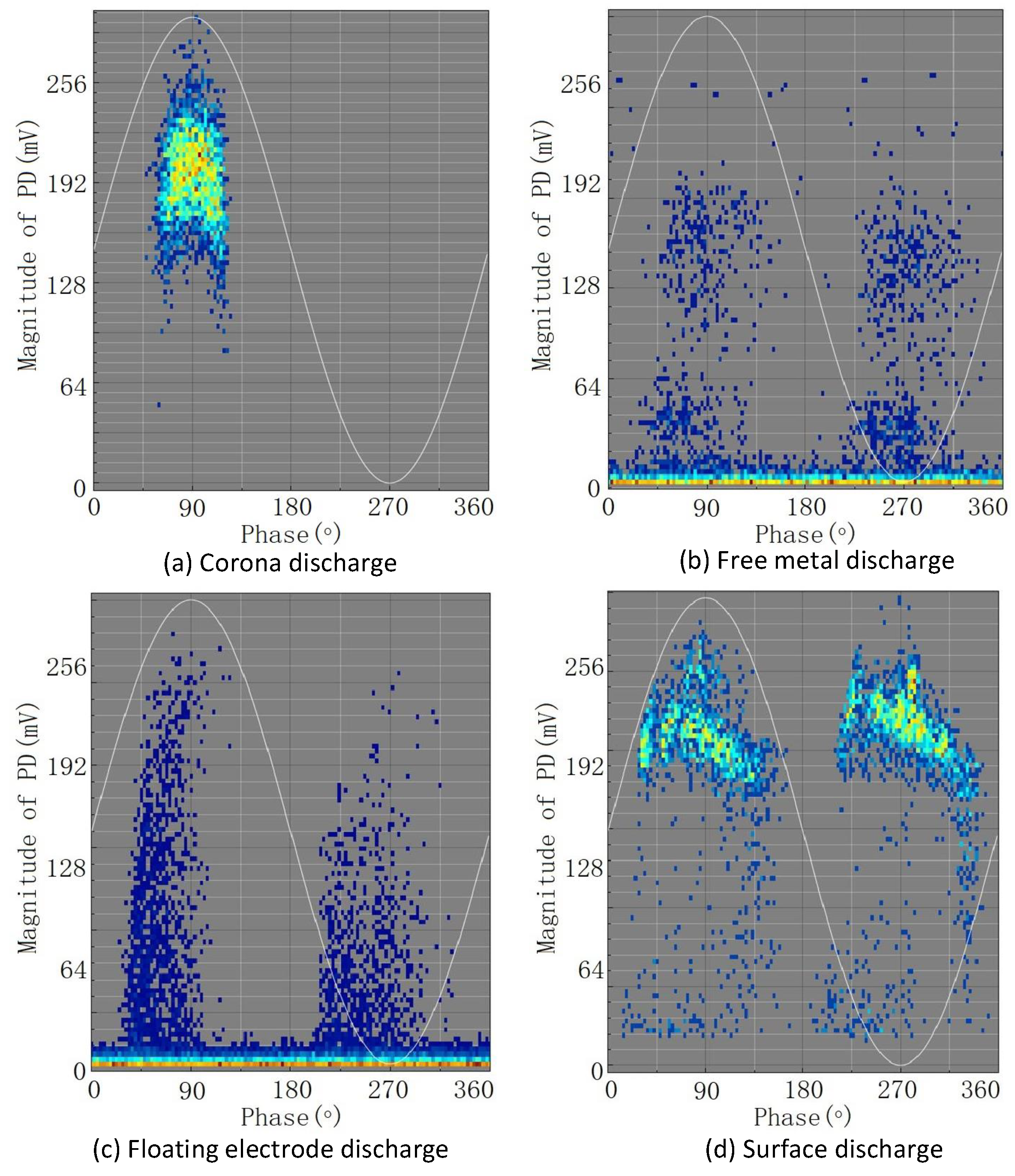
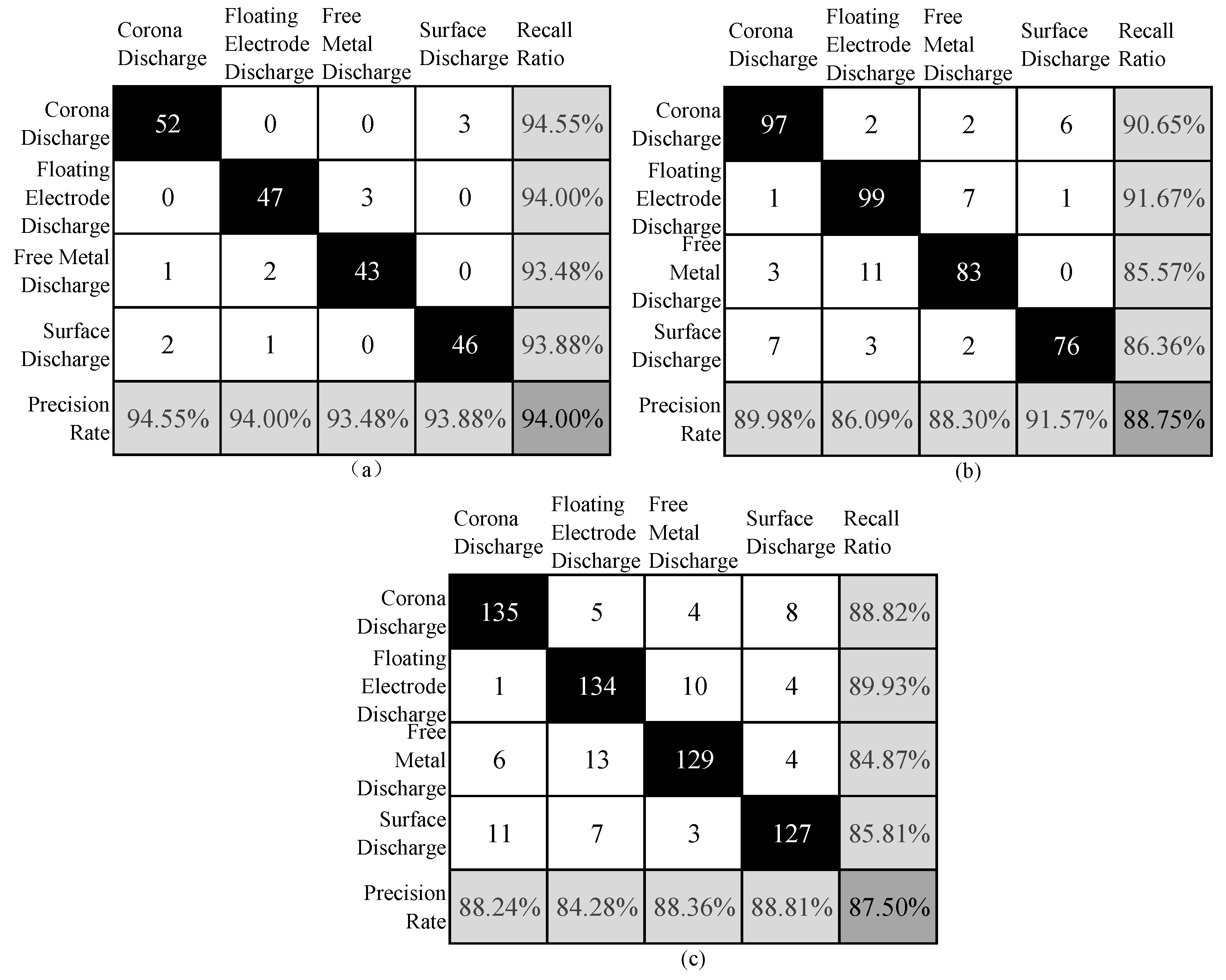
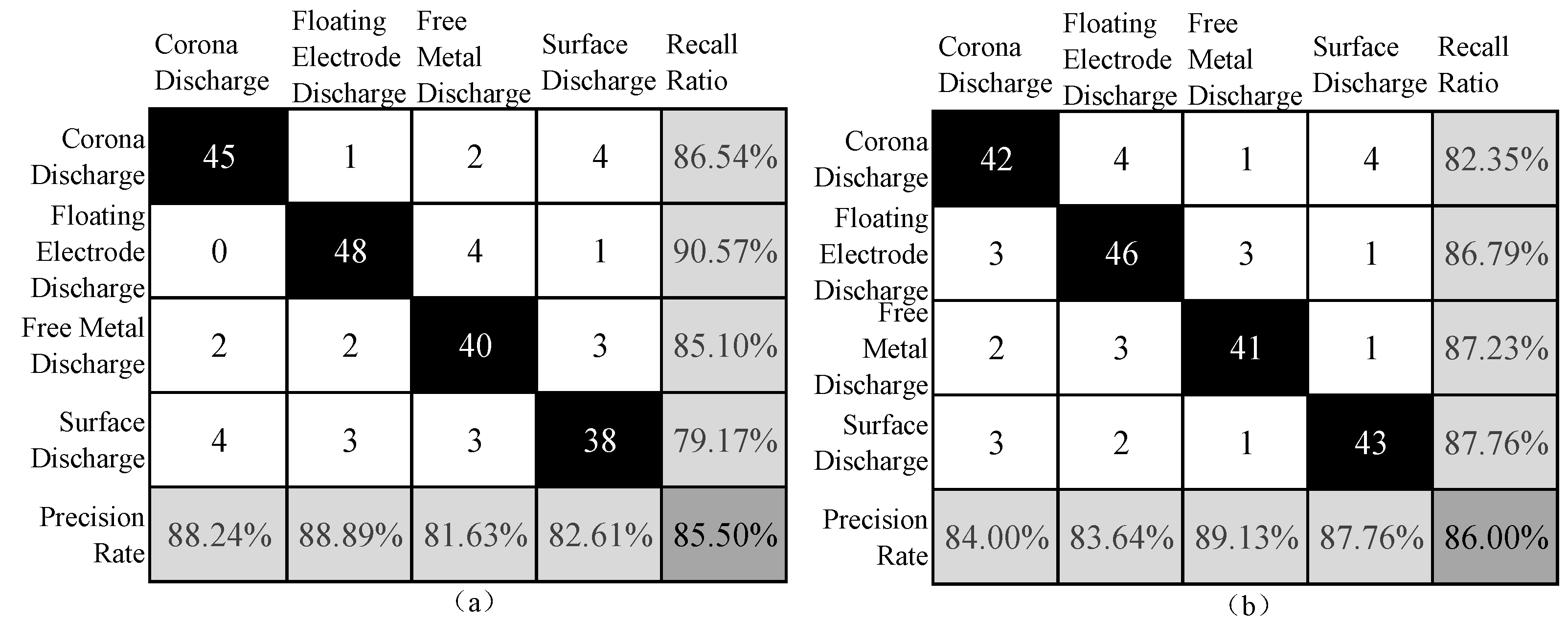
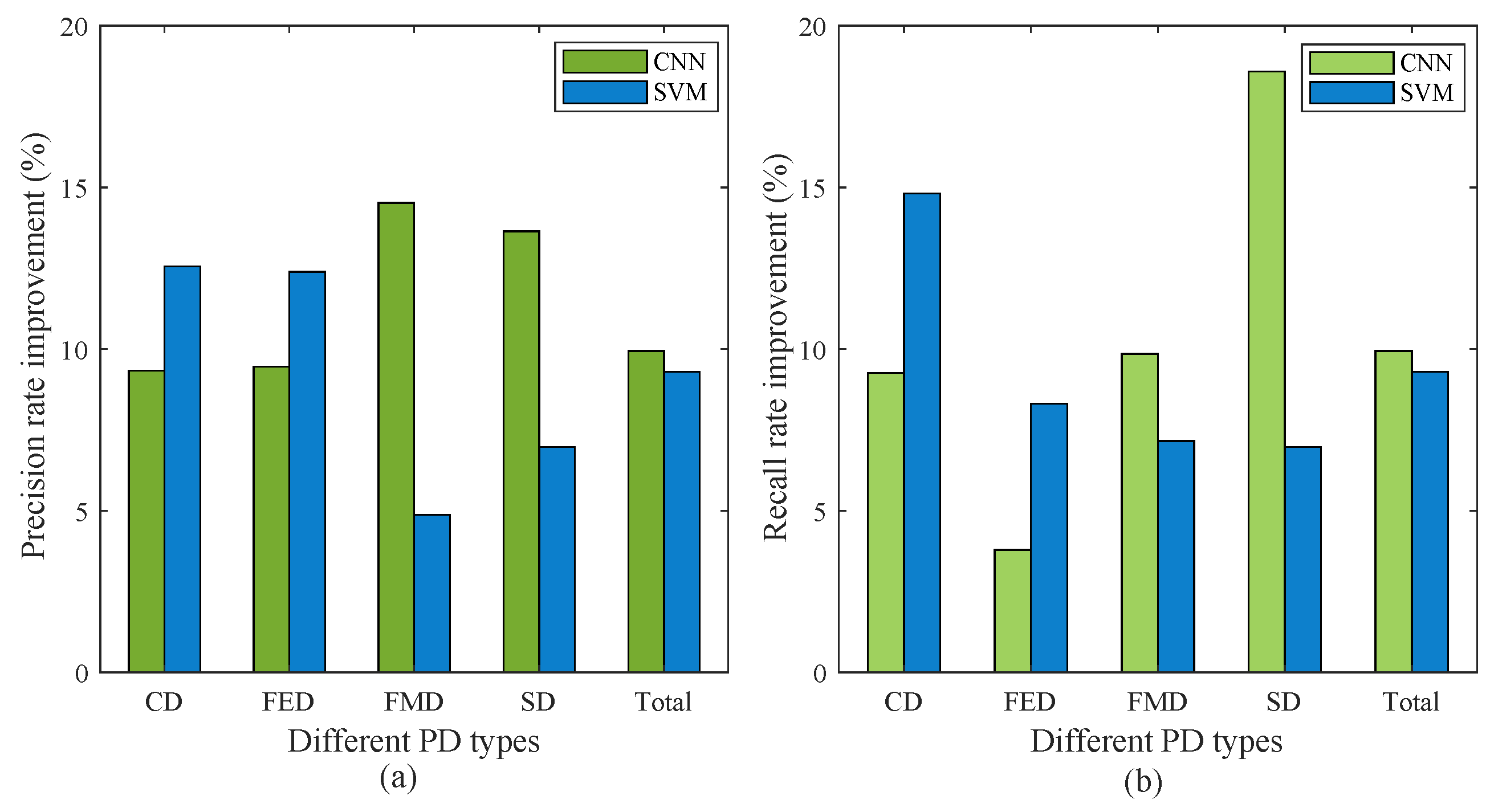

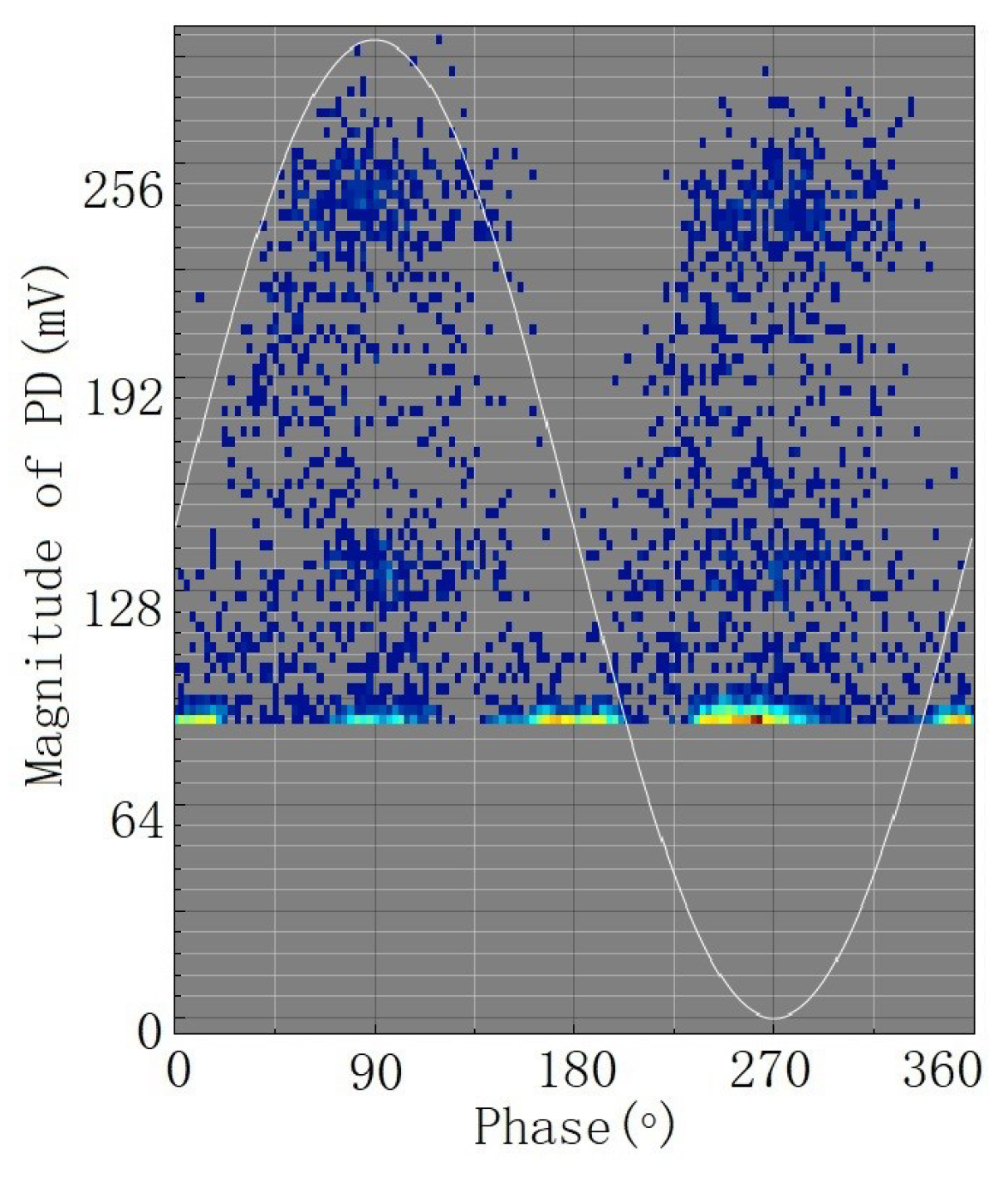
| PD Defect Type | Corona Discharge | Floating Electrode Discharge | Free Metal Discharge | Surface Discharge | Total |
|---|---|---|---|---|---|
| Number | 2 | 26 | 5 | 19 | 52 |
Publisher’s Note: MDPI stays neutral with regard to jurisdictional claims in published maps and institutional affiliations. |
© 2022 by the authors. Licensee MDPI, Basel, Switzerland. This article is an open access article distributed under the terms and conditions of the Creative Commons Attribution (CC BY) license (https://creativecommons.org/licenses/by/4.0/).
Share and Cite
Yin, K.; Wang, Y.; Liu, S.; Li, P.; Xue, Y.; Li, B.; Dai, K. GIS Partial Discharge Pattern Recognition Based on Multi-Feature Information Fusion of PRPD Image. Symmetry 2022, 14, 2464. https://doi.org/10.3390/sym14112464
Yin K, Wang Y, Liu S, Li P, Xue Y, Li B, Dai K. GIS Partial Discharge Pattern Recognition Based on Multi-Feature Information Fusion of PRPD Image. Symmetry. 2022; 14(11):2464. https://doi.org/10.3390/sym14112464
Chicago/Turabian StyleYin, Kaiyang, Yanhui Wang, Shihai Liu, Pengfei Li, Yaxu Xue, Baozeng Li, and Kejie Dai. 2022. "GIS Partial Discharge Pattern Recognition Based on Multi-Feature Information Fusion of PRPD Image" Symmetry 14, no. 11: 2464. https://doi.org/10.3390/sym14112464
APA StyleYin, K., Wang, Y., Liu, S., Li, P., Xue, Y., Li, B., & Dai, K. (2022). GIS Partial Discharge Pattern Recognition Based on Multi-Feature Information Fusion of PRPD Image. Symmetry, 14(11), 2464. https://doi.org/10.3390/sym14112464






